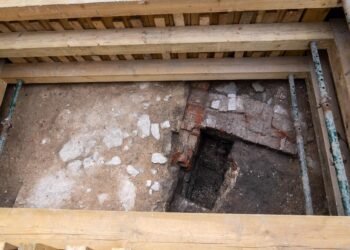by — The ability to make art has often been considered a hallmark of our species. Over a century ago, prehistorians even had trouble believing that modern humans from the Upper Palaeolithic (between 45,000 and 12,000 years ago) were capable of artistic flair.

Discoveries of uncontrovertibly old artworks from the caves and rock shelters of Europe soon dispelled their doubts. But what of the Neanderthals, an ancient, large-brained sister group to our own species? We now know that they were capable of making art too.
However, at present, all of the Neanderthal evidence is non-figurative – they have no depictions of animals, including humans. This latter form of art was perhaps exclusive to Homo sapiens. Instead, the Neanderthal examples consist of hand stencils, made by blowing pigment over the hand, finger flutings – where the fingers were pressed into a soft surface – and geometric markings.
Neanderthals inhabited western Eurasia from about 400,000 years ago until their extinction about 40,000 years ago and have often been caricatured as the archetypal “cavemen”.
Questions about their cognitive and behavioural sophistication have never quite gone away, and whether they produced art is at the forefront of this issue.
Despite the fact that we know that Neanderthals were capable of producing jewellery and using coloured pigments, there has been much objection to the notion that they explored deep caves and left art on the walls.
But recent work has confirmed beyond doubt that they did. In three Spanish caves – La Pasiega in Cantabria, Maltravieso in Extremadura and Ardales in Malaga, Neanderthals created linear signs, geometric shapes, hand stencils, and handprints using pigments. In La Roche Cotard, a cave in the Loire Valley, France, Neanderthals left a variety of lines and shapes in finger flutings (the lines that fingers leave on a soft surface).

And deep in the Bruniquel cave, southwest France, they broke off stalactites into sections of similar length and constructed a large oval wall of them, setting fires on top of it. This was not a shelter but something odder, and if it was constructed in a modern art gallery we’d no doubt assume it was installation art.
Now that we have well-established examples of Neanderthal art on cave walls in France and Spain, more discoveries are inevitable. However, the job is hard because of difficulties in establishing the age of Palaeolithic cave art. In fact, it is often the focus of intense debate among specialists.
Relative dating schemes based on the style and themes of cave art and comparisons of objects recovered from dated archaeological levels have proven useful, but they have their limits.
To produce real ages requires at least one of three conditions. The first is the presence of a charcoal pigment which can be dated using the radiocarbon method. This will establish exactly when the charcoal was created (when its wood died). However, black pigments are often from minerals (manganese) and therefore a large amount of black coloured cave art is simply not dateable.
A further problem is that the production of the charcoal may or may not be of the same age as the date that it was used as a pigment. I could pick up some 30,000-year-old charcoal from a cave floor and write “Paul was here” on a cave wall. The radiocarbon date wouldn’t reflect when my grafitto was actually made.
A second condition is the presence of calcite flowstones (stalactites and stalacmites) that have formed over the art. If they demonstrably grew on top of a piece of art, then they must be younger than it. A dating method based on the decay of uranium into an isotope – a particular form – of the element thorium can be used to establish exactly when flowstones formed, producing a minimum age for the art underneath.
I was part of a team who used this method to date flowstones overlying red pigment art in the three Spanish caves mentioned earlier, demonstrating that hand stencils, dots and colour washes must have been created over 64,000 years ago. This is a minimum age: the actual age of the images could be much older.
But even at its youngest range, the images predate the earliest arrival of modern humans (Homo sapiens) in Iberia by at least 22,000 years. As Middle Palaeolithic archaeology – the calling cards of the Neanderthals – is common in all three caves, the simplest interpretation that fits the dating is that the authors of the images were Neanderthals.
Objections to our results ignored supporting information we’d published. Did the dated samples really overlie the art? They did. Can we trust the technique? We have for half a century.
The third condition has just provided further evidence of Neanderthal artistic activity. Meandering lines left by tracing fingers along the soft muds of the walls of the Roche Cotard cave reveal another form of interacting with this mysterious subterranean realm. These markings include wavy, parallel and curved lines in organised arrangements that show they were made deliberately.
The dating of sediments which formed over its entrance show that it was completely sealed no later than 54,000 years ago – probably earlier. As with our Spanish examples, this was long before Homo sapiens arrived in the region and the cave contains only tools made by Neanderthals. It adds another art form to the Neanderthal repertoire.
Even ardent sceptics must agree that this data unambiguously reveal artistic activities in deep caves which can only have been made by Neanderthals.
The art could represent Neanderthal individuals becoming more aware of their own agency in the world. It might constitute the first evidence of engagement with an imaginary realm. The coming years will no doubt reveal even more subjects for debate.























Comments 0